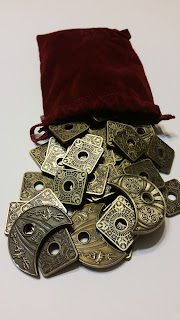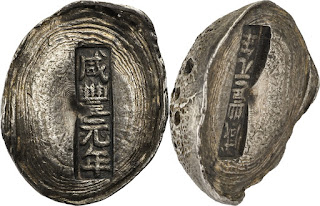D&D Money Oh Dear They Changed The Values Over The Years...
Since I am trying to move my D&D game towards a more Asian type setting here is some information on currency in D&D.
In Old D&D from page 39 of Monsters & Treasures 1974
1 Gold Piece = 10 Silver Pieces
1 Silver Piece = 5 Copper Pieces
If Electrum is added it is optionally worth either twice or half the value of Gold. Platinum is five times more valuable than Gold if it is decided to add it to the precious metals list.
D&D Basic Holmes 1977, 1978
1 Copper Piece = 1/50 Gold Piece
1 Silver Piece = 1/10 Gold Piece
1 Electrum Piece = 1/2 Gold Piece
1 Platinum Piece = 5/1 Gold Piece
or
5 Copper = 1 Silver Piece
10 Silver Pieces = 1 Gold Piece
2 Electrum Pieces = 1 Gold Piece
5 Gold Pieces = 1 Platinum Piece
D&D Basic Moldvay 1981
10 Copper Pieces = 1 Silver Piece
10 Silver Pieces = 1 Gold Piece
2 Electrum Pieces = 1 Gold Piece
5 Gold Pieces = 1 Platinum Piece
In Advanced D&D from page 35 of The Players Handbook 1978
10 Copper Pieces = 1 Silver Piece
20 Silver Pieces = 1 Gold Piece
2 Electrum Pieces = 1 Gold Piece
1 Platinum Piece = 5 Gold Pieces
So before we even get to information presented in Oriental Adventures we have inflation. Copper has been devalued in AD&D as it now takes twice the amount of copper to equal 1 silver piece and silver has gone down in value too as again twice the amount is needed to equal a gold piece but looks like it goes up in value again. I will probably have to look at actual prices of items to figure out how much of this is relevant. I honestly don't remember noticing this much and I think when I was playing as a kid D&D Basic Moldvay was what we used, but since I want to go Old School on my economy while incorporating aspects of Oriental Adventures I do need to consider the currency in Oriental
Adventures.
Oriental Adventures 1985
Fen = 1 Copper Piece
Yuan = 5 Copper Pieces
Tael = 10 Silver Pieces
Ch'ien = 100 Silver Pieces or 5 gold pieces
Copper Piece = 1 Fen
Silver Piece = 10 Fen or 2 Yuan
Electrum Piece = 100 Fen or 20 Yuan or 1 Tael
Gold Piece = 200 Fen, 40 Yuan, or 2 Tael
Platinum Piece = 1000 Fen or 200 Yuan or 10 Tael or 1 Ch'ien
Oriental Adventures also mentions notes, currency exchange, and other economic issues. Honestly I am concerned with a more basic play level. So lets compare the Oriental Adventures 1985 currency and Old D&D 1974 currency:
1 Copper Piece = 1 Fen
5 Copper Pieces or 5 Fen = 1 Yuan and therefore 1 Silver Piece (using 1974 chart)
10 Silver Pieces or 10 Yuan = 1 Tael and therefore 1 Gold Piece in (using 1974 chart)
1 Gold Piece or 1 Tael = 50 Copper Pieces or 50 Fen, 10 Silver or 10 Yuan (using 1974 chart)
Electrum is a bit of a choice as in OD&D it could be 1/2 a Gold Piece or twice the value of the Gold Piece, in looking at the currency lists the oldest Basic Rules went with 1/2... later it became codified to twice the value. So for my little fantasy world I am going with the 1/2 value.
1 Electrum Piece = 25 Copper Pieces or 25 Fen, 5 Silver or 5 Yuan (using 1974 chart)
1 Platinum Piece = 5 Gold Pieces or 5 Taels, 250 Copper Pieces or 250 Fen, 50 Silver or 50 Yuan, 1 Ch'ien (using 1974 chart)
Is this historically correct probably not; but we are talking fantasy money; so I am not worried to much about being that accurate. I am more concerned with having a currency system I can use easily with Old D&D and players can grasp. These values are more important to understand how to properly price items in the game, and figuring out encumbrance.
Next I will have too look at various price lists to see if more adjustments are needed.
Currency in a fantasy world need not look like modern money and might take a huge range of shapes. Real world coins are not all the same shapes. Money in some cultures is traditionally strung or sown onto clothes. In addition something to keep in mind when looking at terms like Tael you could have a Tael of Silver which than would equal 10 Silver Pieces and a Tael of Copper would equal 50 Copper Pieces, thus the Asian terms act can also act as measurements of various metals.













Comments
Post a Comment